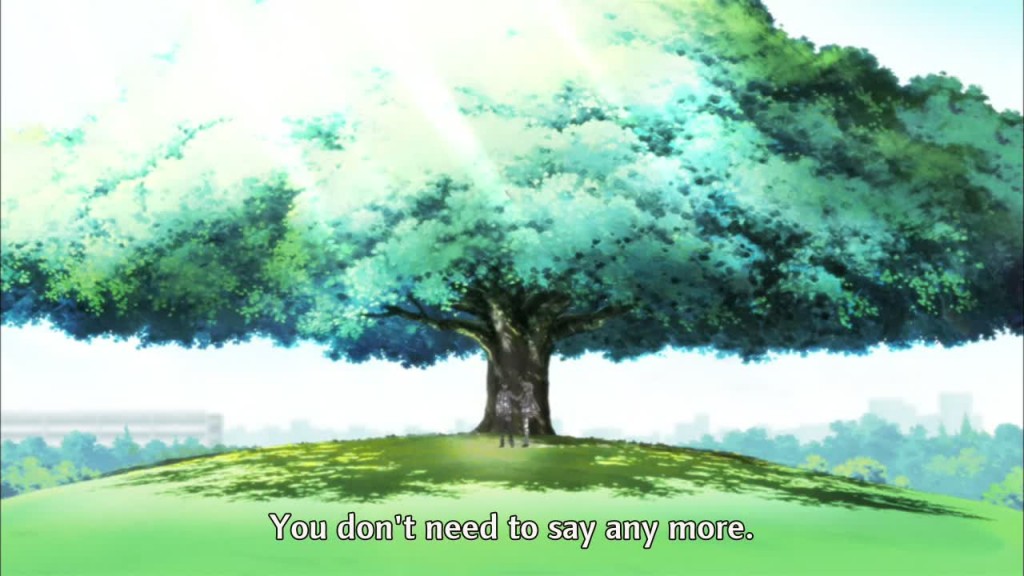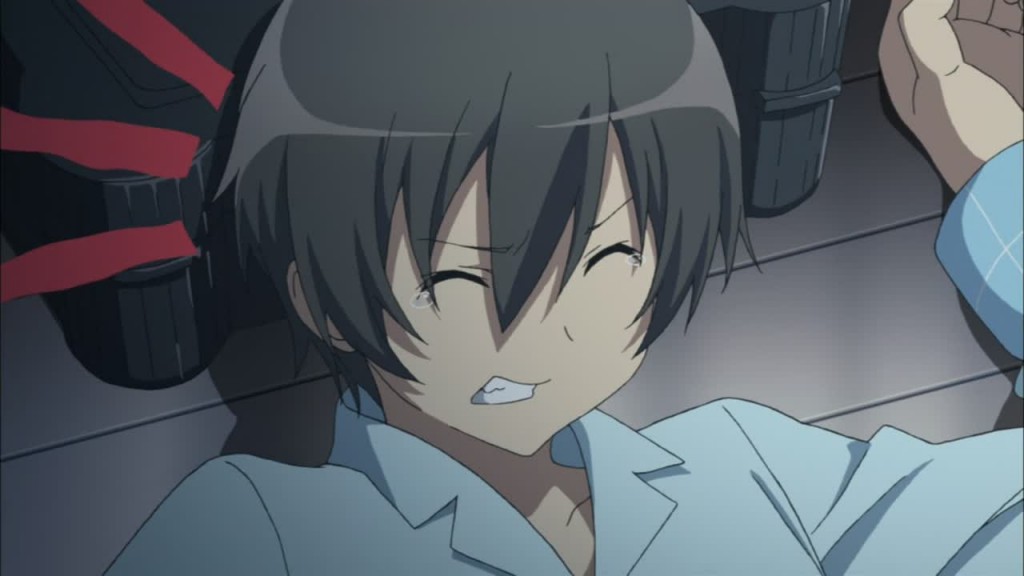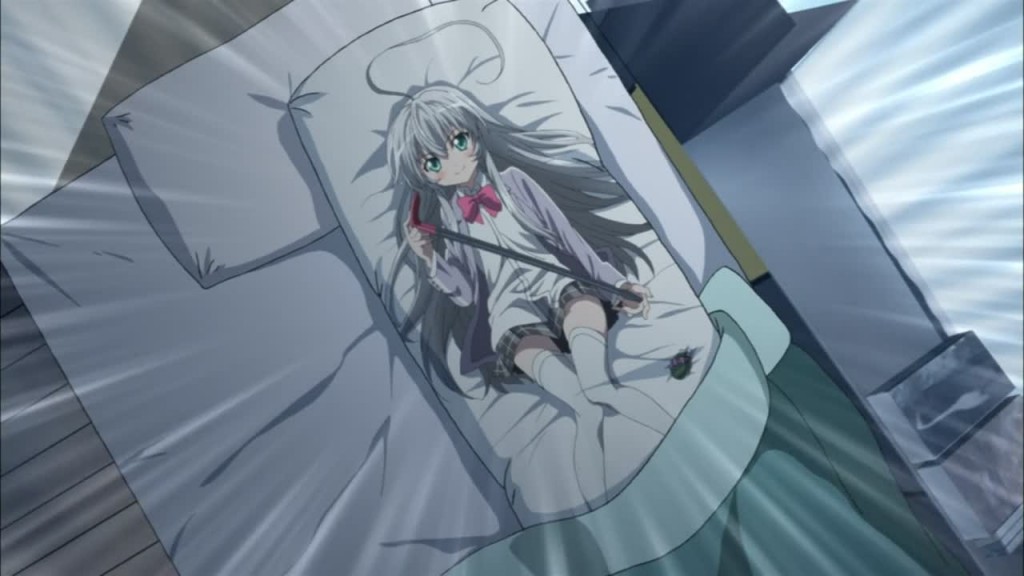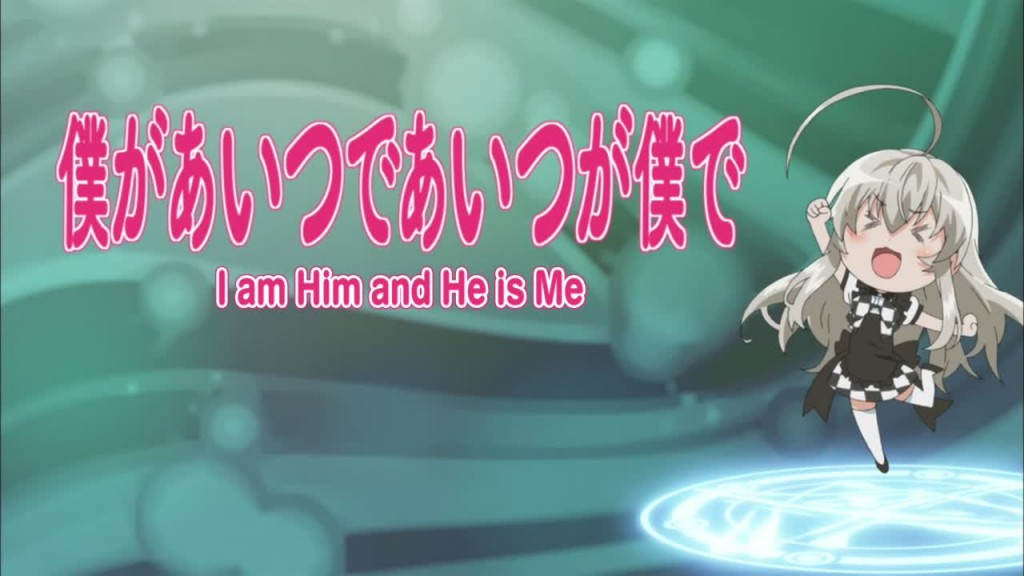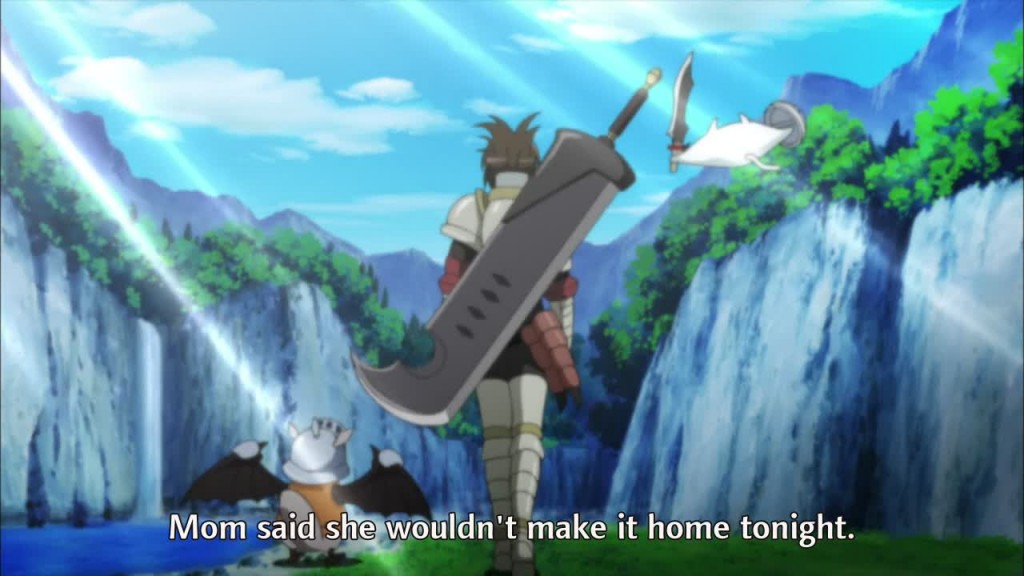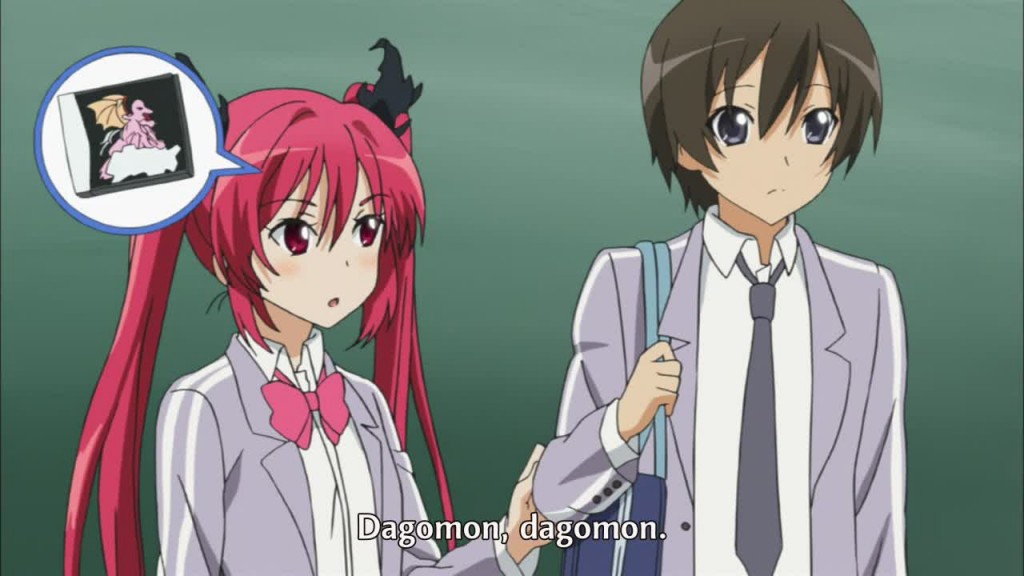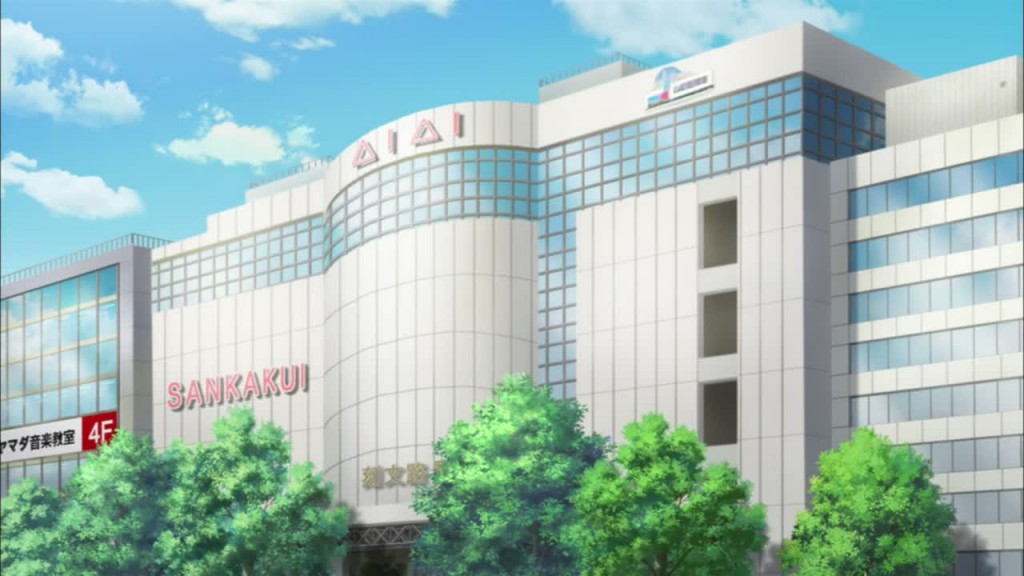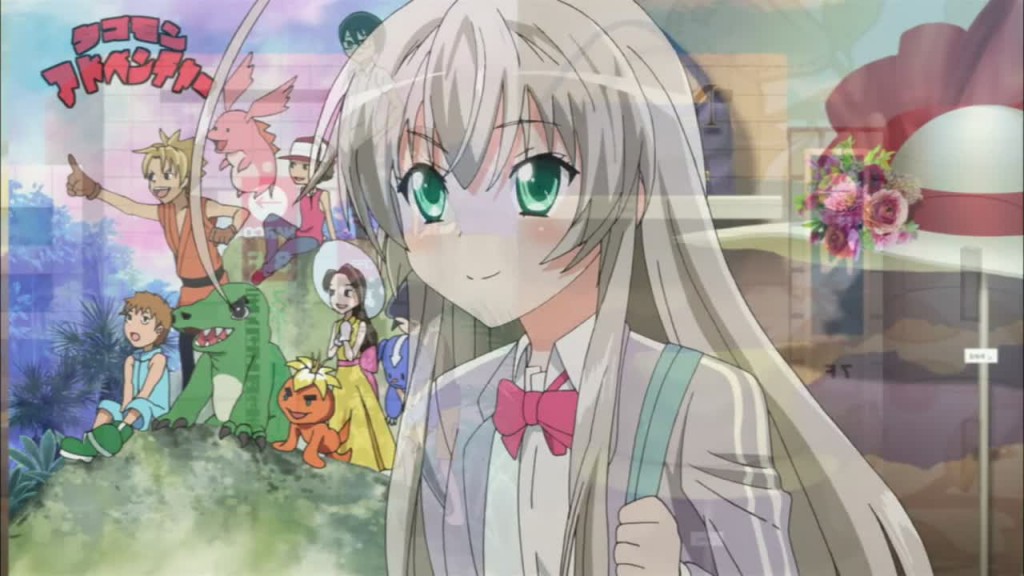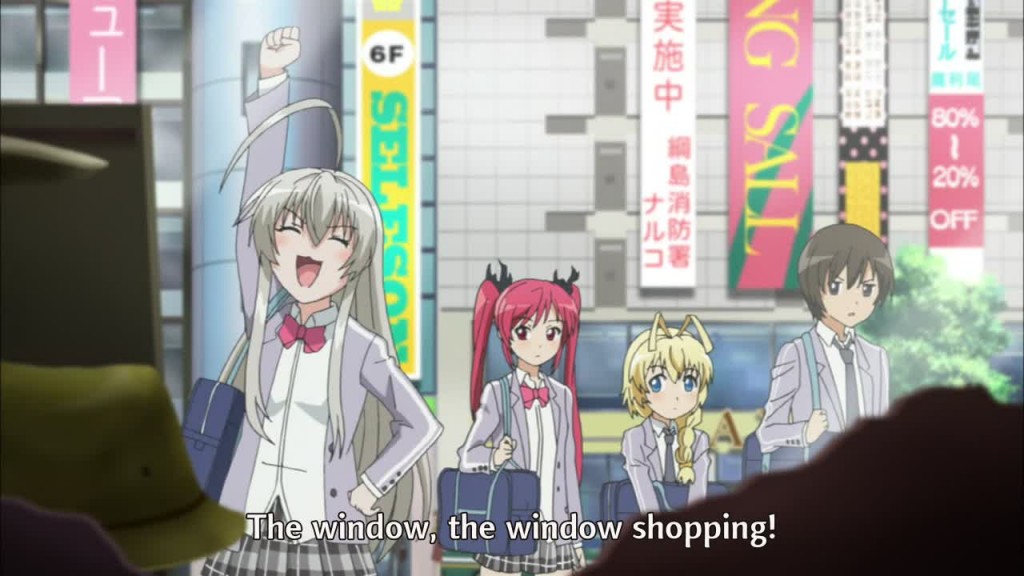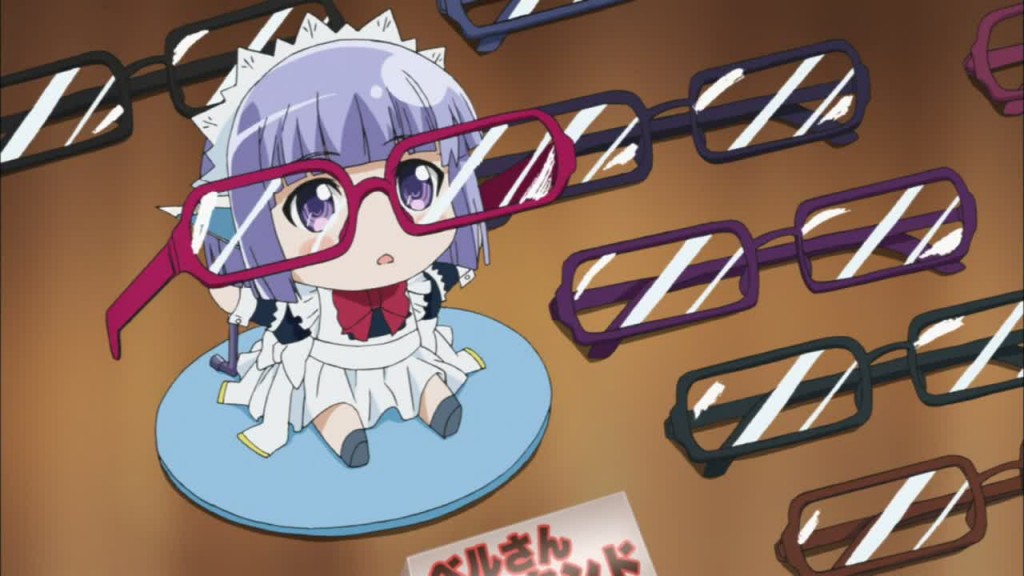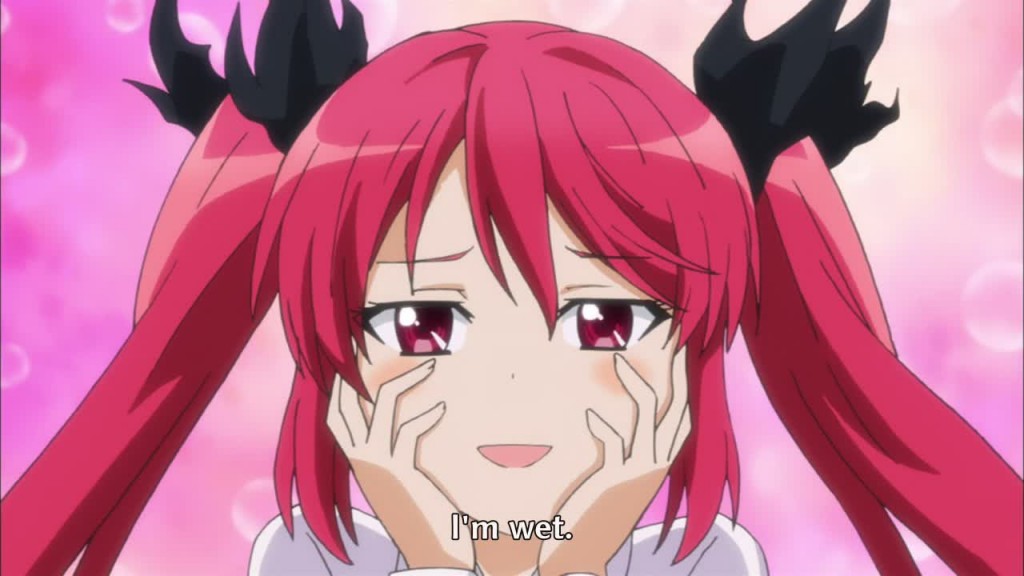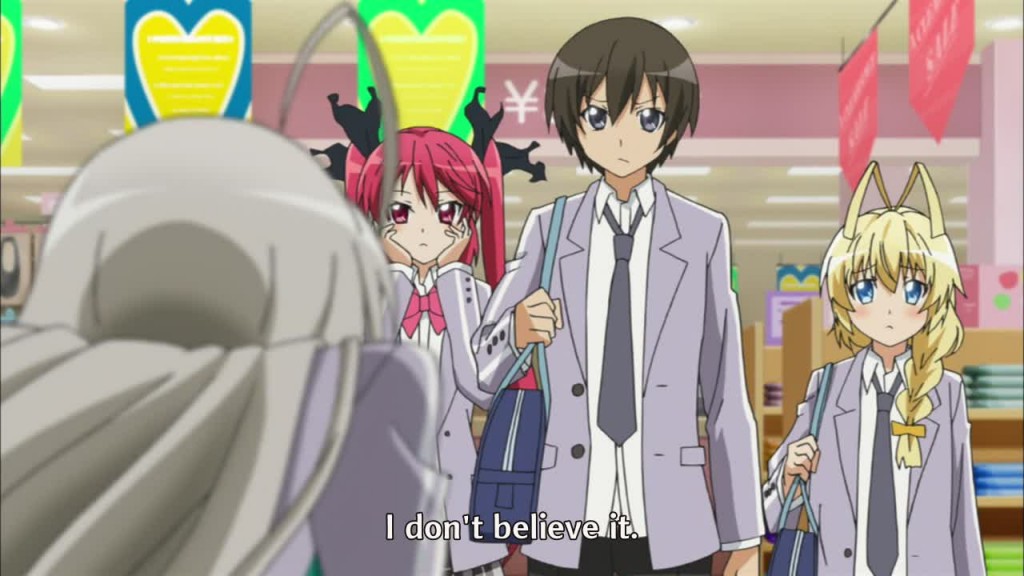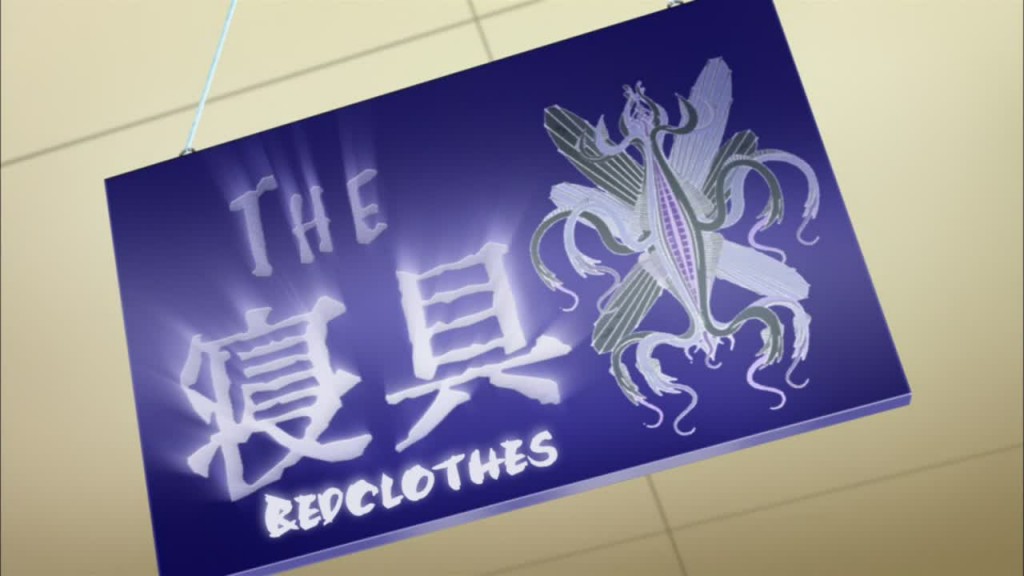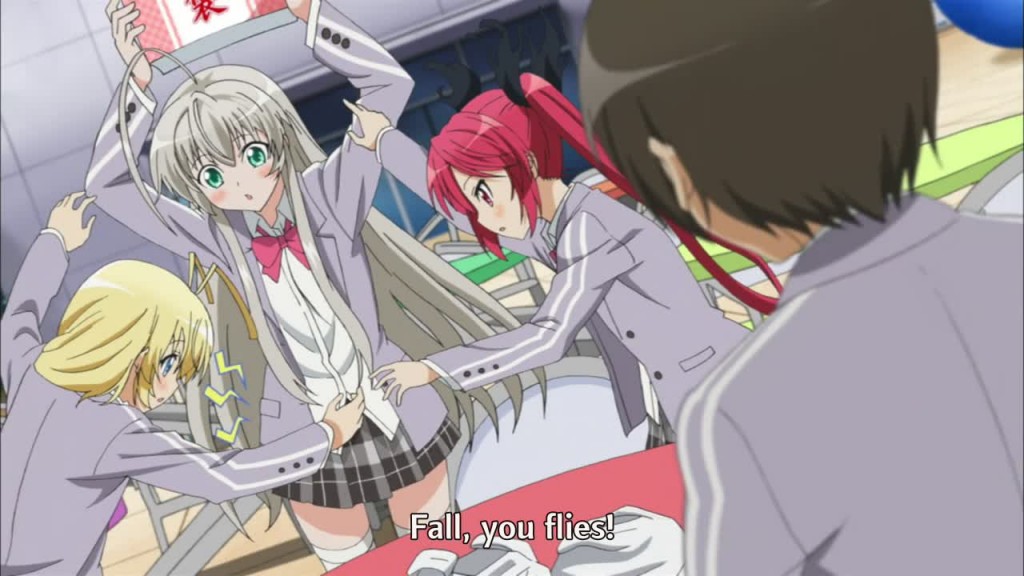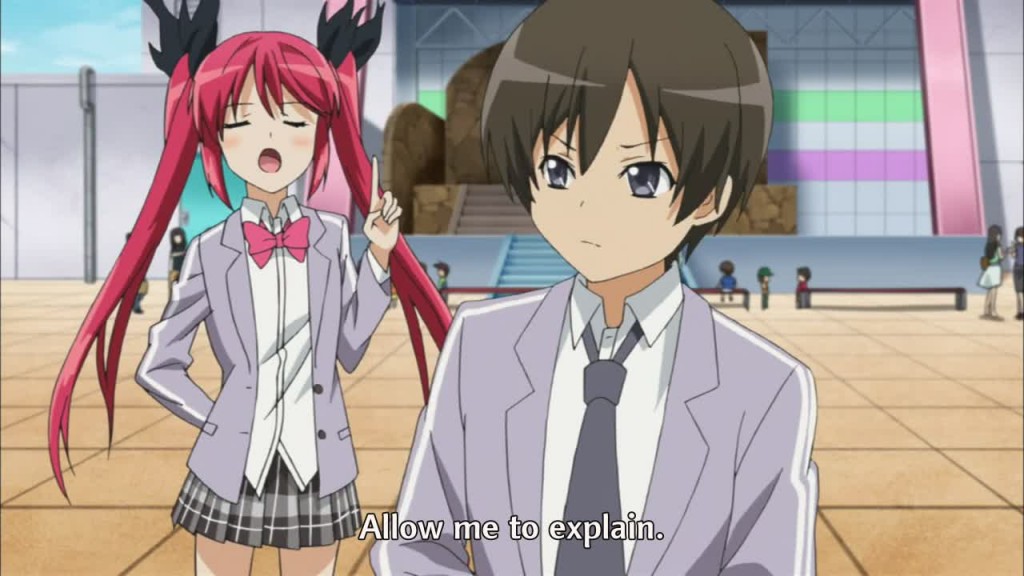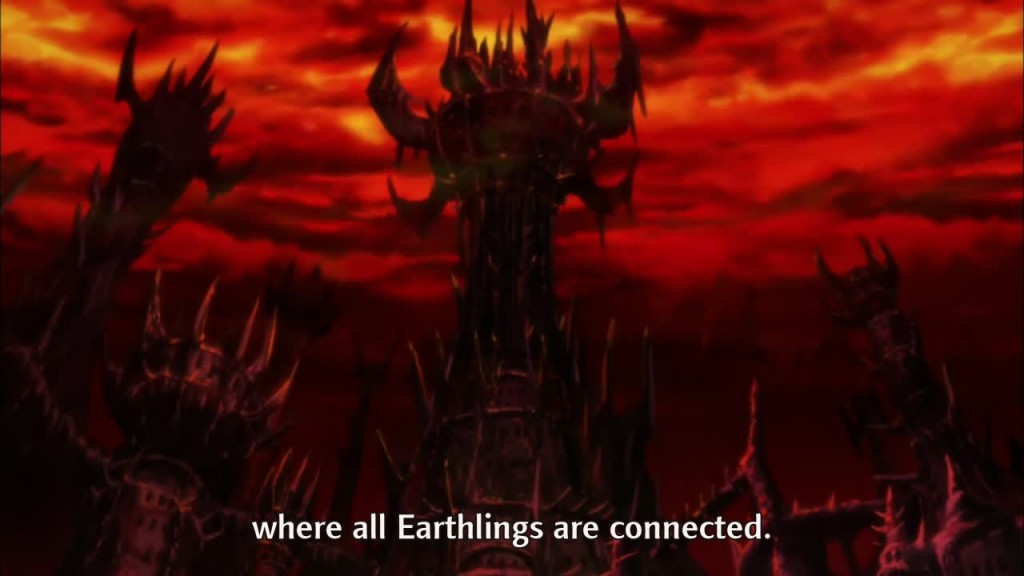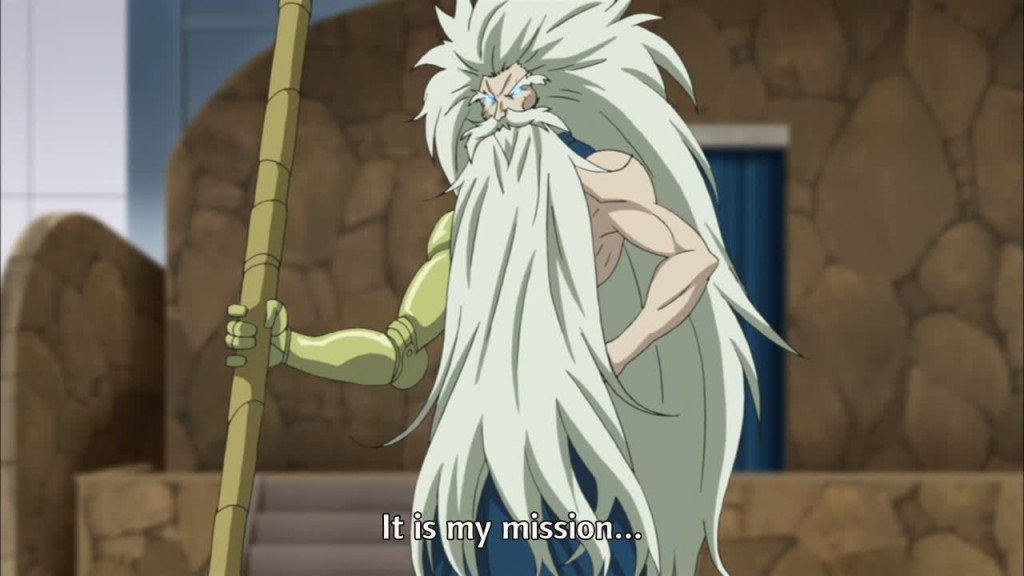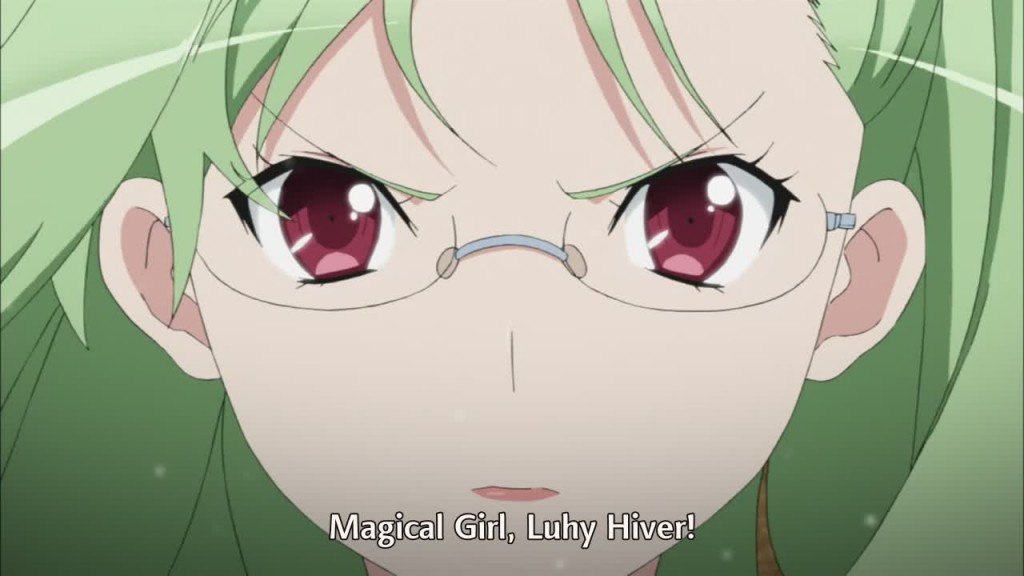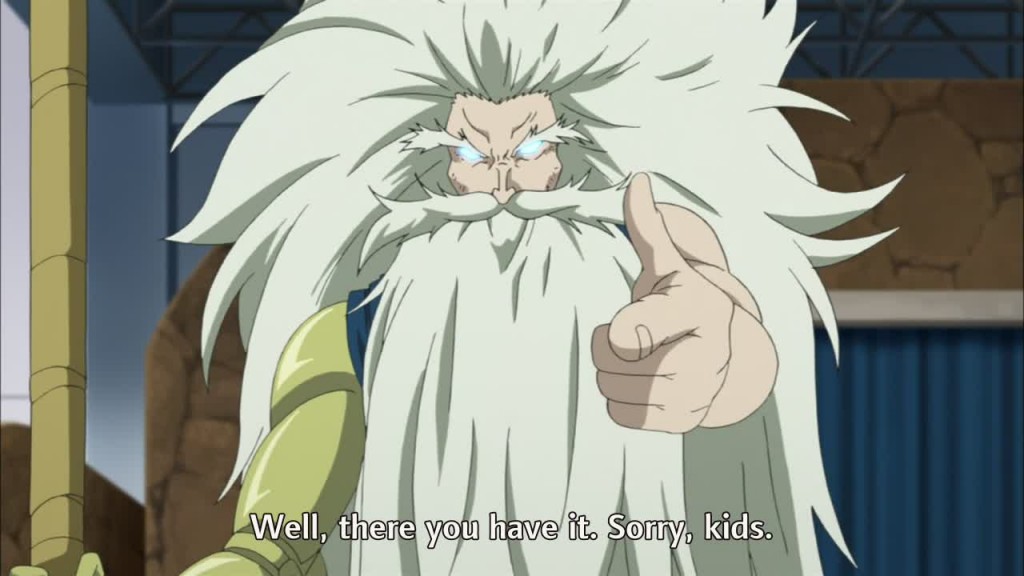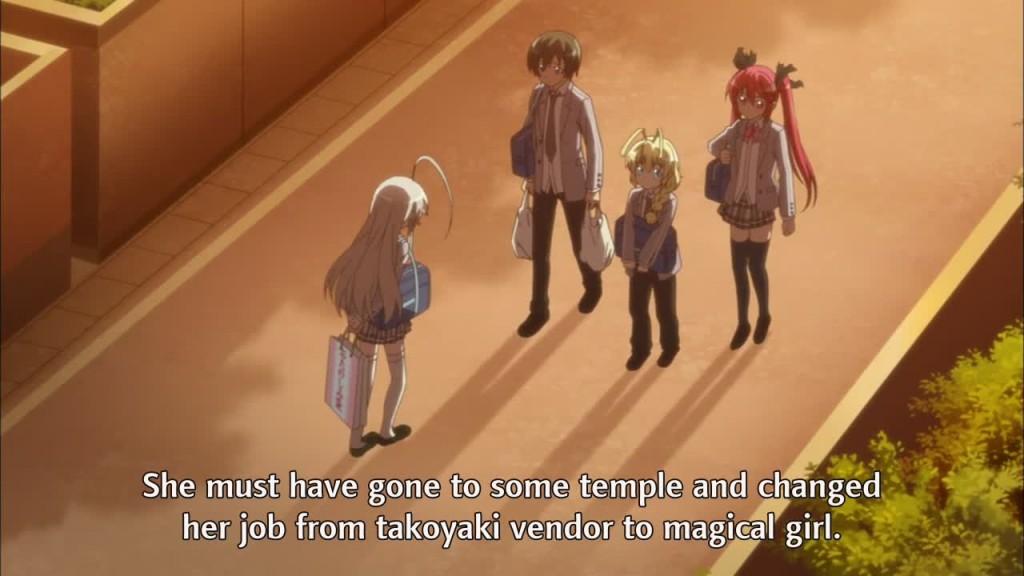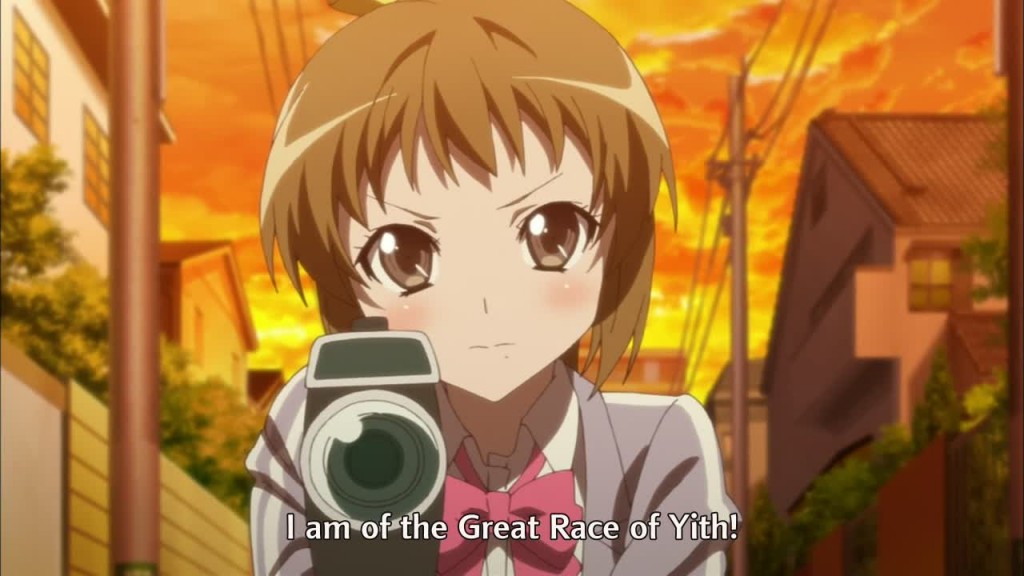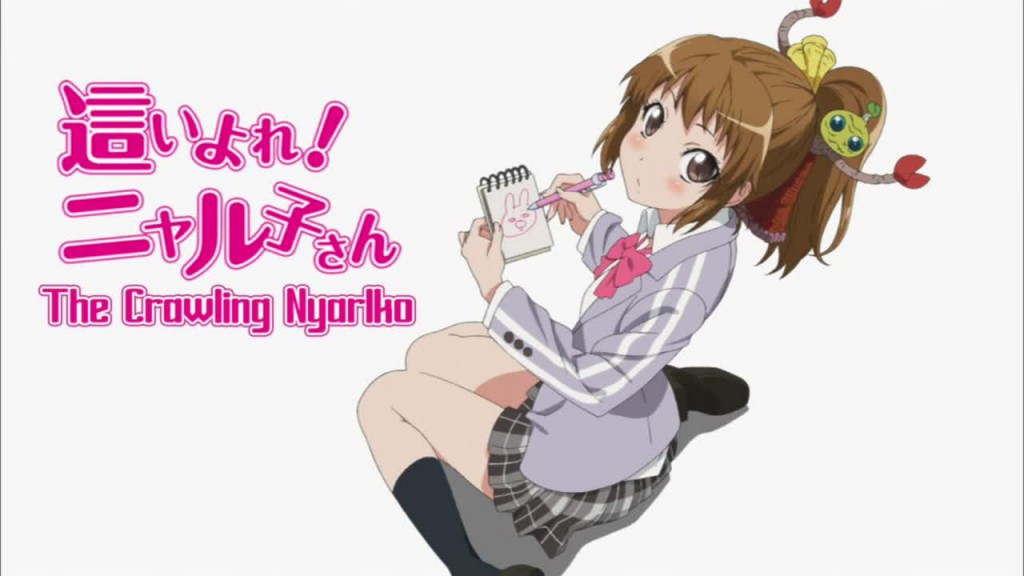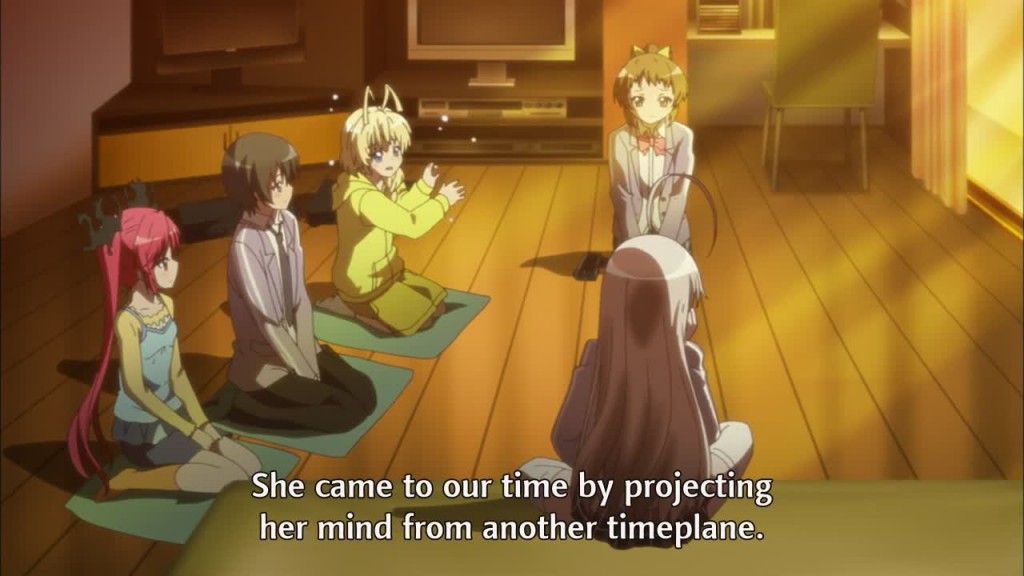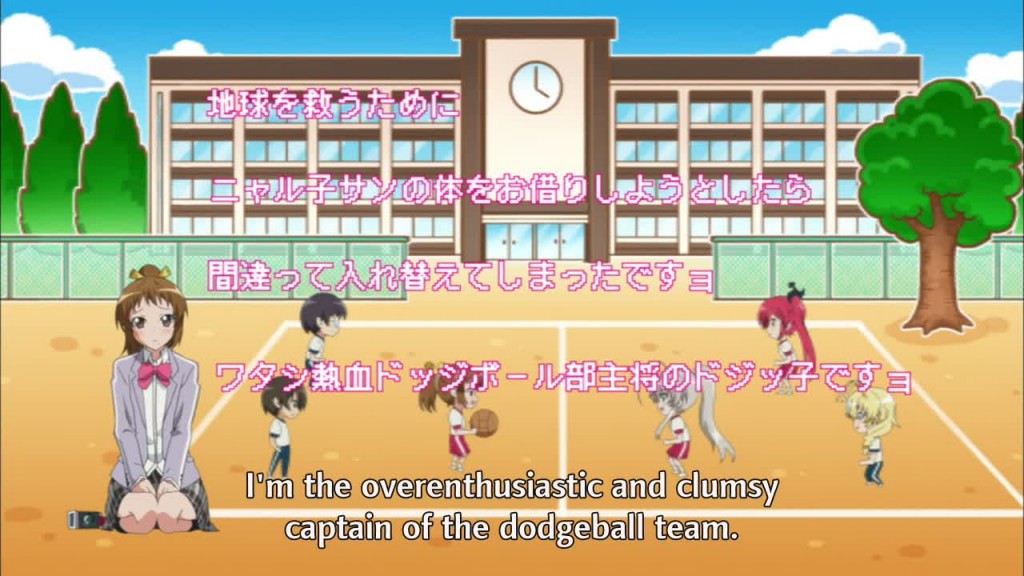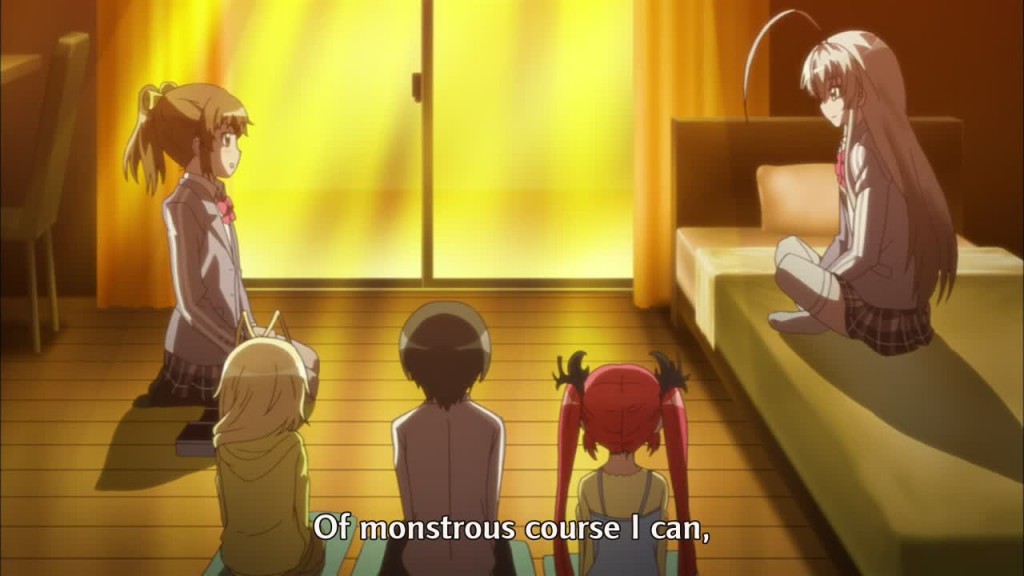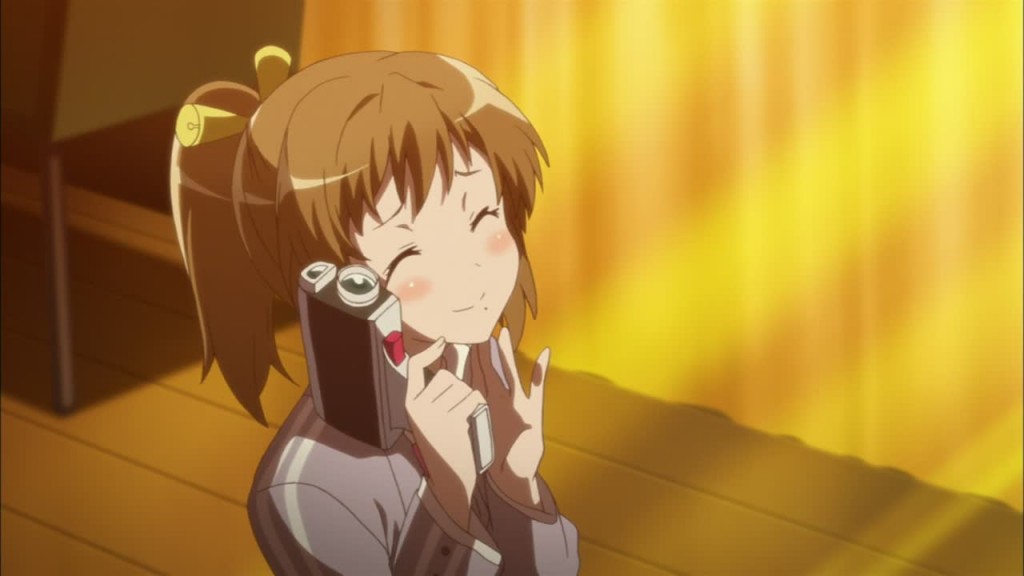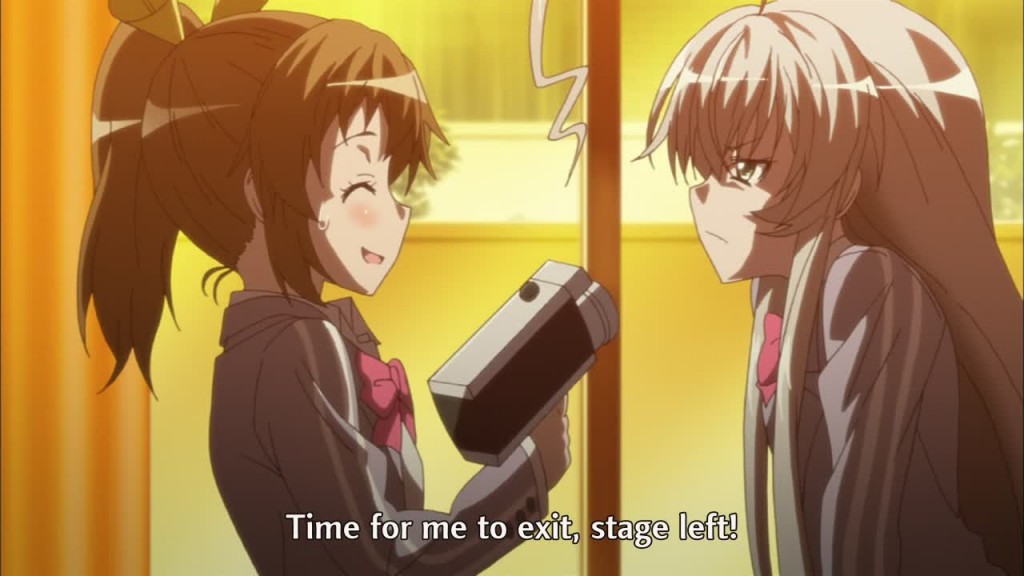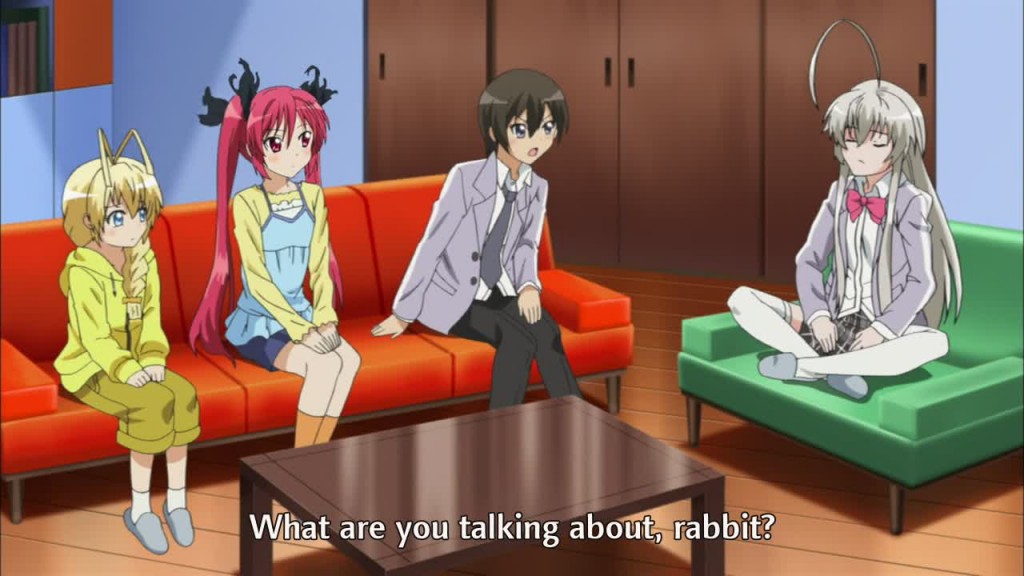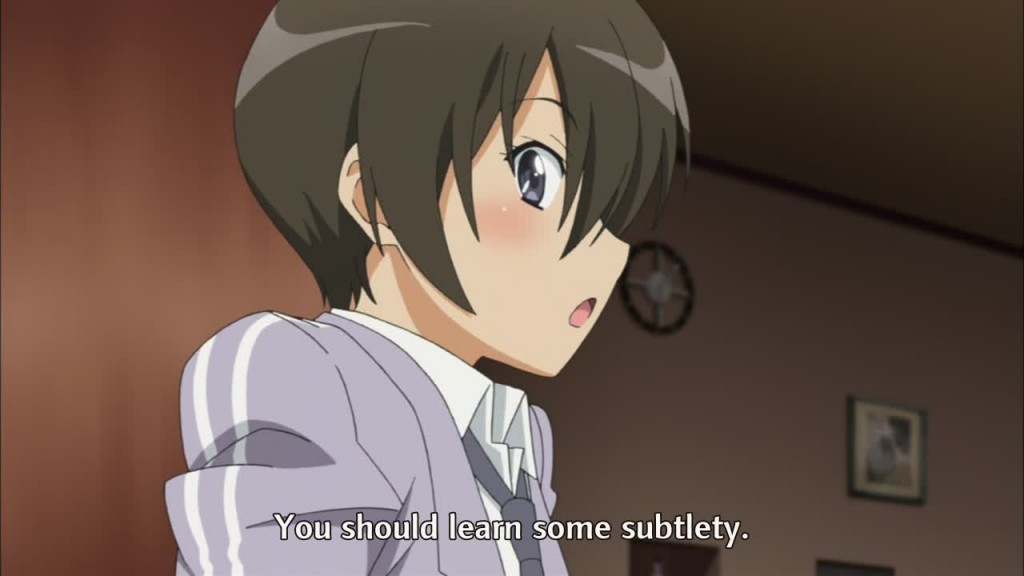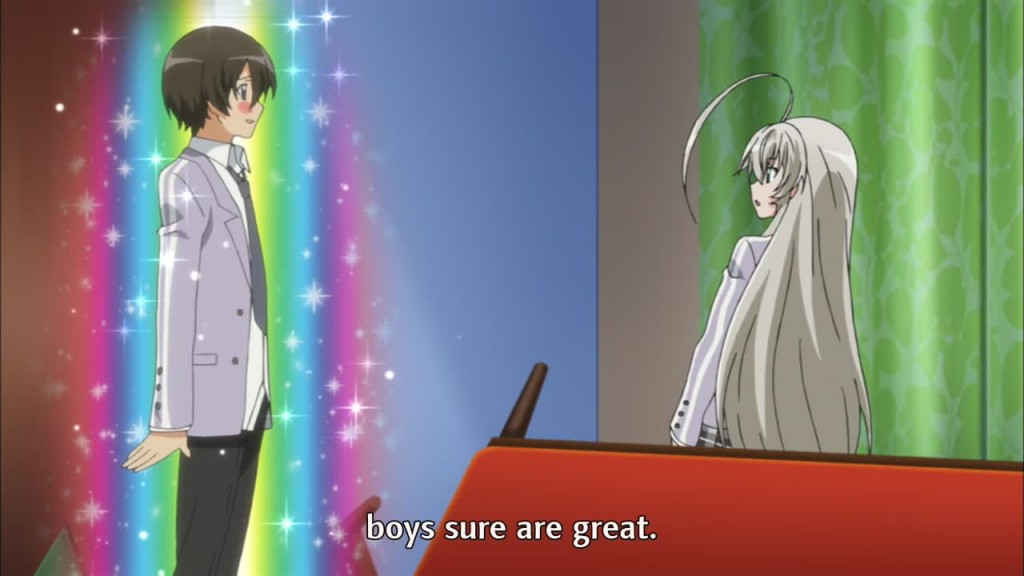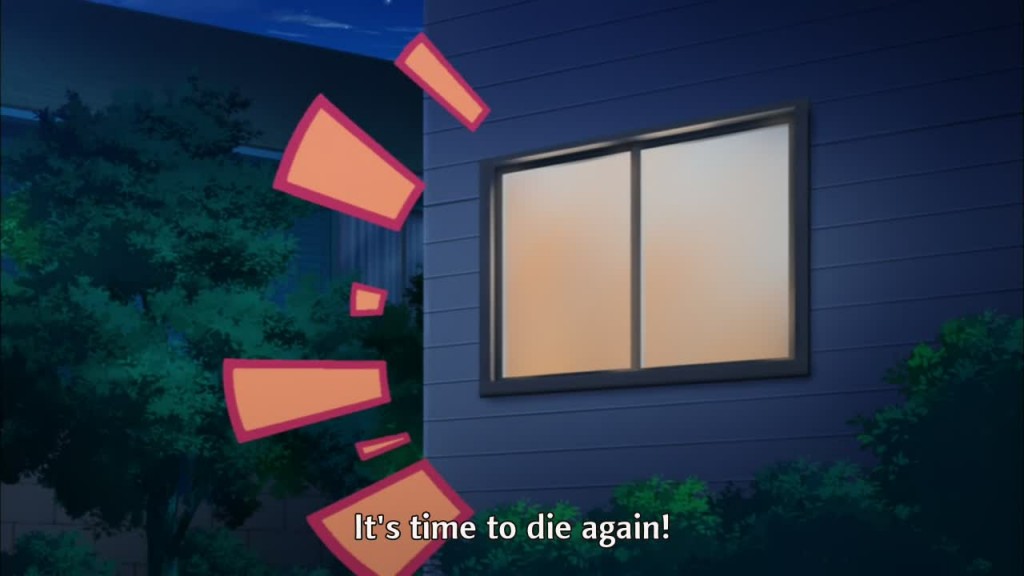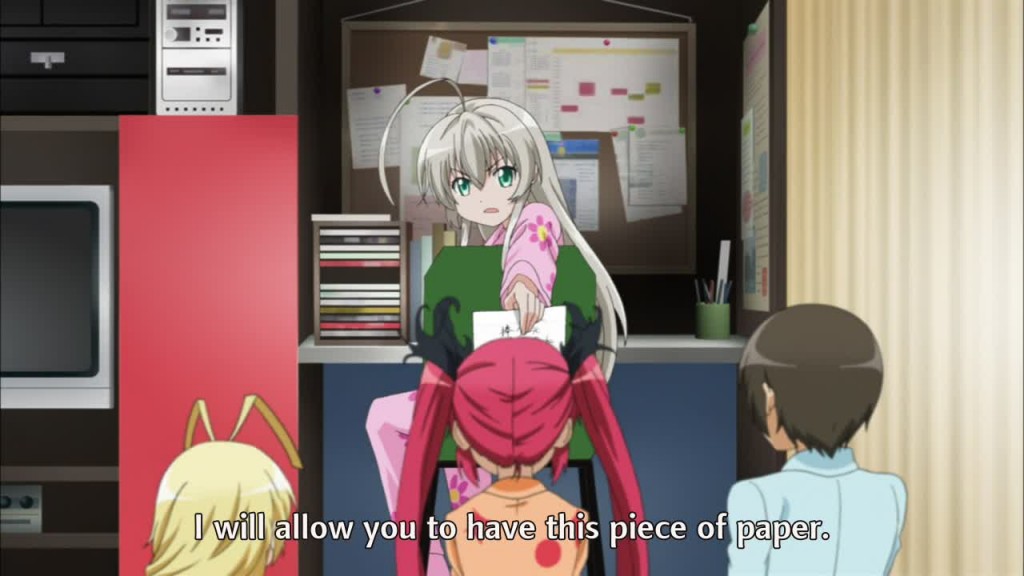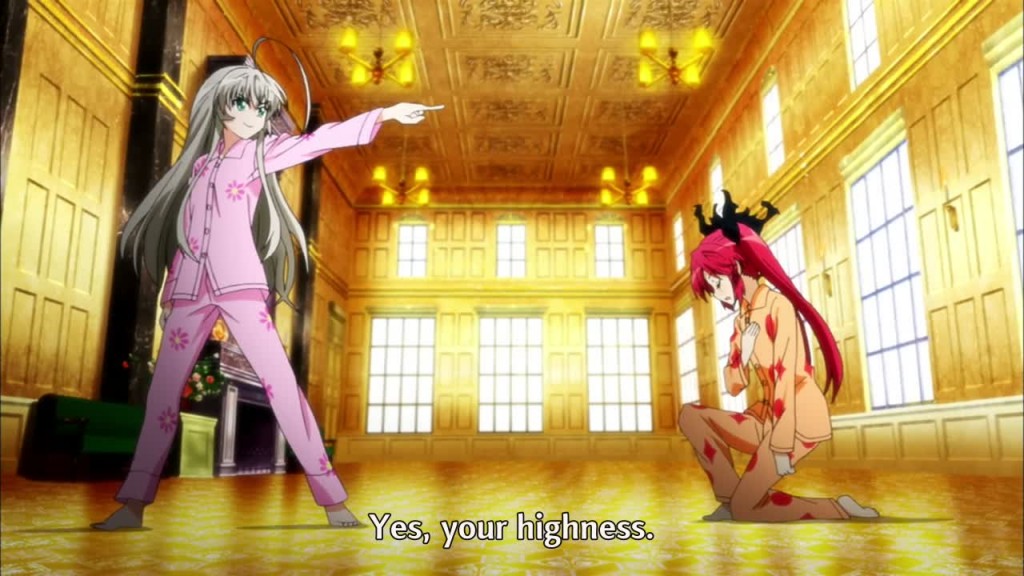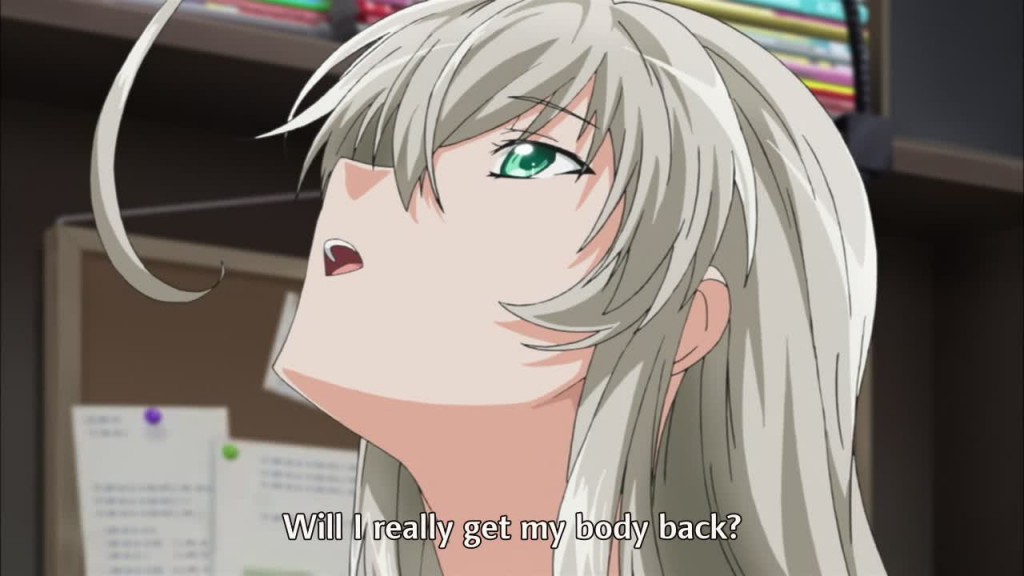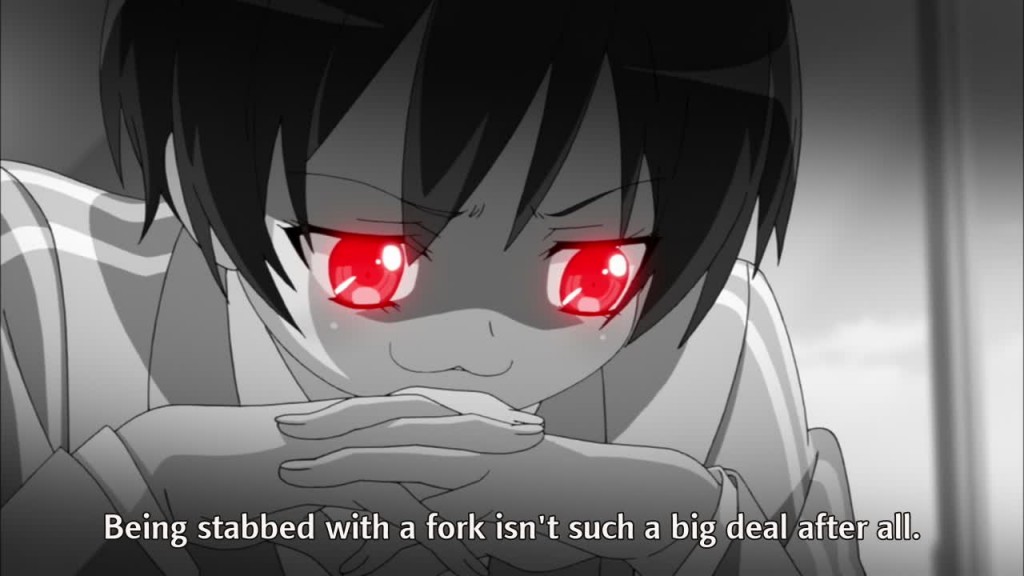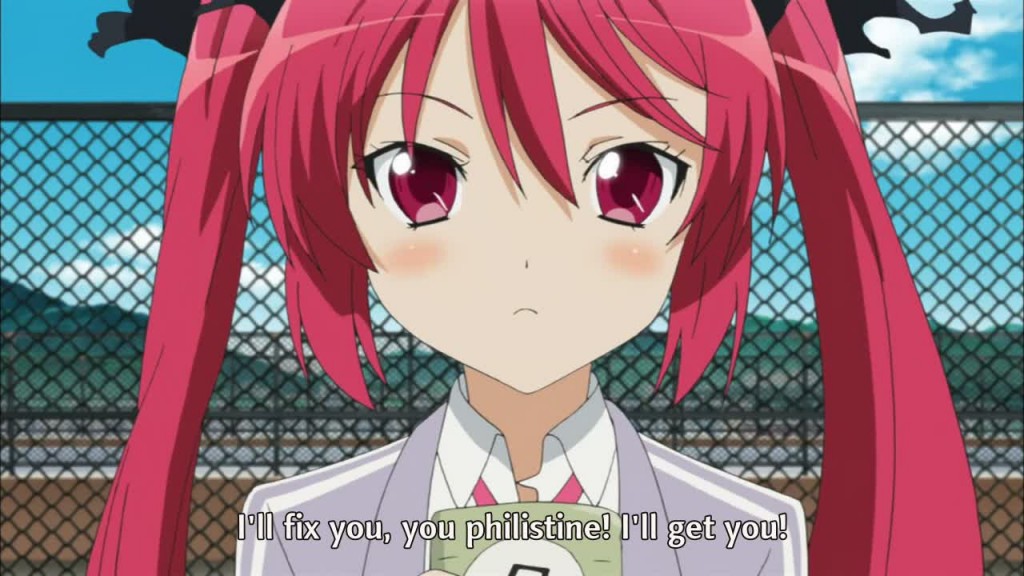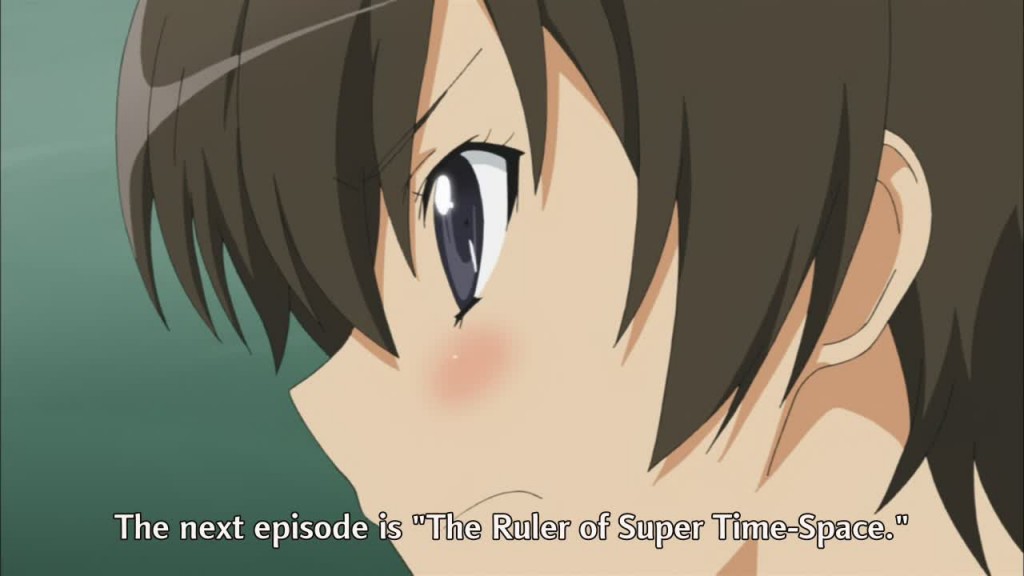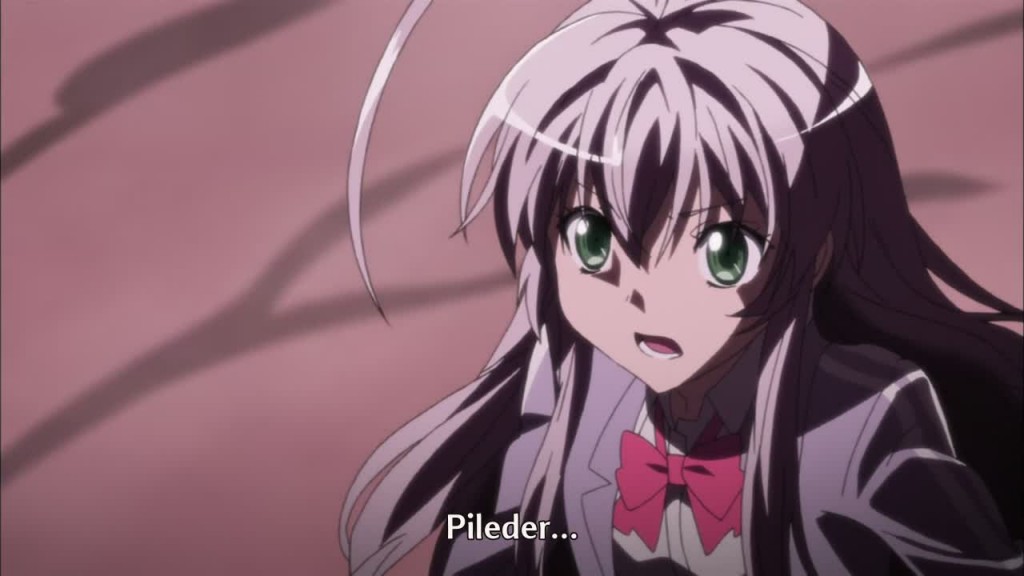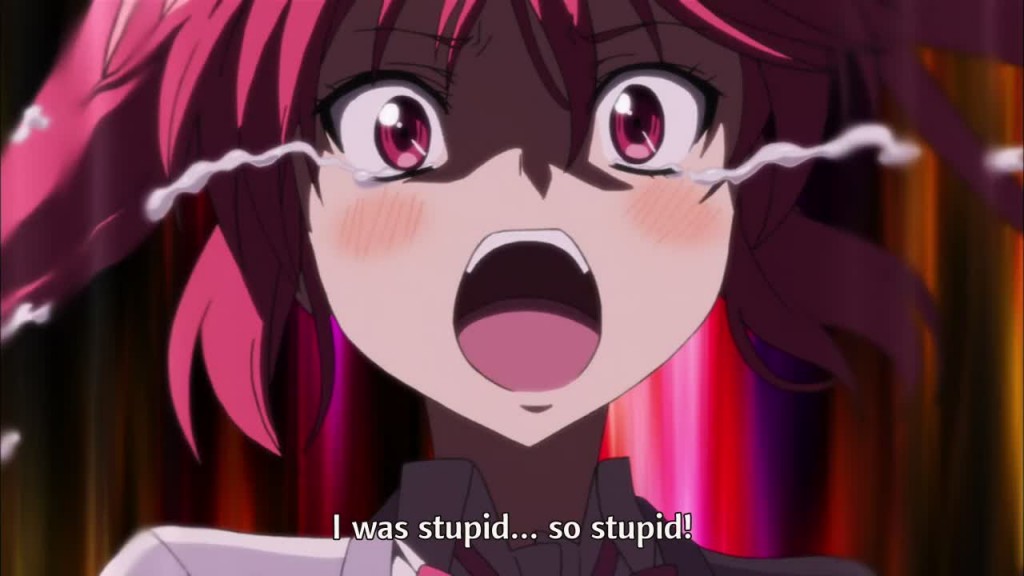Haiyore! Nyarlko 09 – notes and the like This entry was posted by Vale.
I know it was ages ago, but I want to finish the first season before starting with the second.
This tree reminds me a lot of the similar big tree in Negima, but then again such hills with one big tree are quite a common element in romantic visual/light novels.
The console’s a Panasonic 3DO.
They’re actually selling those hug pillows.
Refer to the preview in episode 8.
As always with her scenes, this is a Monster Hunter reference too. All their equipment are based on “real” stuff in Monster Hunter (Buster Sword, Odyssey etc).
The cover references Pokemon Black. There is a Digimon called Dagomon, named after the deity Dagon of the Cthulhu myth.
Both the logo and the name reference Marui (logo: OIOI). 三角 (sankaku) means triangle. The station name (hidden partially behind the trees) can be read as Kokubunji, which is a reference to Kokubunji in Tokyo.
Continuing the earlier Dagomon line: Dagomon Adventure, a reference to Digimon Adventure. The poster itself is an obvious homage to the defining anime of my childhood.
Reference to Dagon (get it? Dagomon and Dagon in one scene) where “The window! The window!” are the ending words of the story. On this note: Lovecraft’s works are available in digital formats for free. You should totally read them if you’re even just a bit interested (most are short stories, so you don’t have to work through thousands of pages either).
That’s Berutein (the sign says Beru-san), from another of Aisora Manta’s works.
A reference to Saeko’s line in Highschool of the Dead.
Reference to Misumi’s catchphrase from Futari wa Precure.
The text (The 寝具 shingu, homophone of “thing” in katakana) is a reference to The Thing, and the creature drawn there is an Elder Thing from (for example) the Mountains of Madness.
Her ringtone is one of Scirocco’s lines from Zeta Gundam. Scirocco’s voice actor also voices Nodens in this anime.
This is a very famous catchphrase from the archaic (late-70s) anime Yattaman (also known as Yatterman), where the narrator used it all the time.
This concept is called the “collective unconscious”, coined by Carl Gustav Jung. The Dreamlands are the main stage of Lovecraft’s Dream Cycle novels.
The music is Watashi Majikaru sung by the voice actresses of Luhi and Yoriko. Nodens’s line is again an almost exact quote of Scirocco from Zeta Gundam. Shimada Bin must like to reference himself…
References R’lyeh Lulu (流家ルル) from Hazawa Kouichi’s eponymous light novel (魔海少女ルルイエ・ルル). The “Hiver” is a reference to Yumi’s Tekkaman form from Tekkaman Blade 2. Her dress is the same as on the cover of the Fatal Attraction drama CD.
The transformation itself and the pose are probably Sailor Moon references. This last “sparkle” is probably referencing Ranka’s famous きらっ during her song Seikan Hikou from Macross Frontier. I say “probably” because both the transformation sequence and kira are very common in magical girl anime. It might as well be a Star Driver reference for all I know (this applies to her “Gorgeously, I have arrived” too, which might be a reference to the Star Driver galactic pretty boy transformations, all of which follow a similar template).
Guess what, he’s quoting Scirocco again. His next “Staff! Staff!” one is a reference to Kano Eikou’s running gag (you can hear him say it for example in Ikemen Kano 3).
A reference to the Dharma Temple in the Dragon Quest games, where players can change character class.
The Great Race of Yith first appears in the Shadow Out of Time. Her introduction is very much like Eiji’s introduction from SPT Layzner. As for her weapon, let me quote the Shadow Out of Time: “An enormous army, using camera-like weapons which produced tremendous electrical effects, was kept on hand for purposes seldom mentioned.”
The notepad with the bunny is a reference to Kurei’s voice actress. She did pretty much the same during one of the promotional niconico events (titled ニコニャル nico-nyaru). The creature in her hair is of the Great Race of Yith, as can be seen on the cover of the issue of Astounding Stories where The Shadow Out of Time was first published.
Yith are mental time travelers. Also the way Hasta introduces her suspiciously resembles how Doraemon introduced himself.
Super Dodge Ball (熱血高校ドッジボール部 nekketsu koukou dodgeball bu) reference. Her way of speaking (adding a small yo at the end of the sentences) is a reference to the alien that possesses Ai from the adult game Hateshinaku Aoi Kono Sora no Shita.
Reference to the monster Mochiron (which also means “of course”) from Ultraman Taro.
キャピ (kyapi) is a meaningless interjection that supposedly originates from a ’80s slang adjective describing cute women. Very few actually use it nowadays (thus the weird reaction of the others).
Her original line references the comedy manga THE MOMOTAROH where “oitoman” is the signature phrase of the character Kurama. But “oitoman” is also a parody, of the ancient manga 8man (eito-man). The translation is a reference to Snagglepuss.
This line references the second verse of the well known Japanese children’s song The Hare and the Turtle (うさぎとかめ, listen for nanto ossharu, usagi-san). The song itself is based on the story of The Tortoise and the Hare from Aesop’s Fables.
(S)he uses the word デリカシー (delicacy), which is the catchphrase of Miu from PapaKiki. Both Miu and Mahiro are voiced by Kitamura Eri.
The rainbow background references the adult game Duel Love, where the same things happen once you reach the heavenly stage (ヘヴン状態). What she says references the “catchphrase” (or rather: standard ending phrase) of Mizuno Haruo’s Wednesday Roadshow (水曜ロードショー).
一遍、死んでみる (ippen shindemiru) is a part of Hell Girl’s curse. Mahiro uses it in the imperative form here (“go die again!”).
“I’ll grant you the rights to this paper.” This is a reference to the 2ch “reward” meme Yaruopoona, where the 2ch mascot Yaruo (やる夫) “grants” someone the rights to buy Opoona (a Wii game). It’s not unlike the English “here, have a cookie”.
If you don’t recognize this reference, stop and go marathon Code Geass now. The entire scene, words, poses, even the flash in Mahiro/Nyarlko’s eye are Code Geass references.
This pose reminds me a lot of Senjougahara Hitagi from Bakemonogatari.
Dio used pretty much the same words when convincing Kakyouin in Jojo. Her/his pose is commonly known in Japan as the Gendo pose after the notorious leader of NERV in Evangelion. Her/his :3 mouth and red eyes are probably a reference to QB from Madoka (who spent the whole series trying to convince Madoka).
Gundam Gundam Gundam. Kamille from Zeta Gundam, Haman from Zeta Gundam and Neil Dylandy from Gundam 00.
超時空の覇者 (chou-jikuu no hasha). The 時空の覇者 part is a reference to Final Fantasy Legend 3, known originally as サガ3時空の覇者 (saga 3: jikuu no hasha, SaGa 3: Ruler of Time-Space), re-released in 2010 for DS with the subtitle Shadow or Light. The 超 (chou, super~) is either just a twist for the sake of twisting, or a reference to (The Super Dimension Fortress) Macross.
Should say “Pilder”, a reference to “Pilder on!” said whenever Mazinger Z and the Jet Pilder connect.
Sayaka’s famous line from Madoka. Sayaka was also voiced by Kitamura Eri.
By the way, all along writing these notes I couldn’t shake off the deja vu that I’d done this before. I clearly remember looking up all these stuff and most of the sources were already in my browser history. Creepy.
